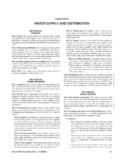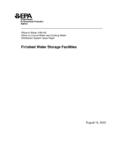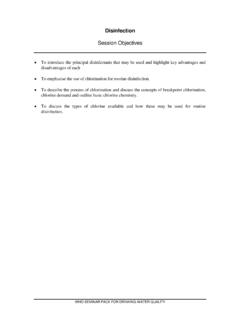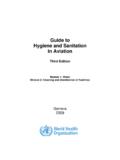Transcription of Water Age: Background Information on …
1 Water AgeNovember 20021 Water Age: Background Information on distribution system Areas ofConcernFindings from White PaperWater age, the time from when the Water is treated to when it reaches the customer, impacts the qualityof Water reaching the customer. Many finished Water quality problems result from interactions betweenwater within the pipe and the pipe wall, and within the bulk Water . Increasing Water age increases thereaction time, allowing for additional formation of contaminants that can lead to adverse health are the Water quality problems that pose a risk to public health?Disinfection byproduct (DBP) formation (organic): DBPs are formed by reactions of disinfectants withorganic matter. Reaction time is a key variable in DBP production. Potential health effects includecancer and problems with the liver, kidneys, and central nervous system . Nitrification: Bacteria oxidize nitrogen compounds (primarily ammonia from the source Water or fromthe chloramination disinfection process) and form nitrite and nitrate.
2 Nitrifying bacteria have slowgrowth rates, thus these problems usually occur only in large reservoirs or low-flow sections of thedistribution system . Nitrate and nitrite cause illness in infants, and if untreated can cause death. Bluebaby syndrome is commonly associated with nitrite or nitrate survival and growth: Areas of low or stagnant flow provide more favorable conditions formicroorganism accumulation or growth compared to well-circulated areas. Microorganisms can attach orintegrate into existing biofilm or sediment and thus be shielded from residual disinfectants. Somemicroorganisms found in the distribution system and their related health effects include the following:bacteria (M. avium complex associated with chronic diarrhea, lung disease); protozoa(Acanthamoeba associated with corneal inflammation); algae (blue-green algae produce neurotoxins);and fungi (Cryptococcus neoformans associated with meningitis, lung infections).
3 Corrosion: Increased residence time can allow for increased corrosion. Corrosion control methodsinvolve phosphate inhibitors and pH management that can be adversely affected as residence timeincreases in poorly buffered waters. Corrosion of unlined cast iron can decrease chlorine residual levels. What contributes to increased Water age?When designing expansions or upgrades to distribution system infrastructure, Water systems shouldconsider fire flow and future growth needs. Fire flow needs not only increase storage requirements butalso pipe size (particularly in residential areas), compared to those needed solely for the provision ofdrinking Water . As a result, flow through the pipes is slower and the turnover rate of stored Water is oftenless. Designing and building according to future demands can also have similar indicates increased Water age?The following Water quality problems are indications of increased Water age: discoloration; watertemperature changes (stagnant Water will approach ambient temperature); reduced disinfectant levels;elevated DBPs, bacteria, taste and odors, and nitrite/nitrate prevention and mitigation methods are available?
4 Design standards: Ten State Standards, AWWARF, and AWWA provide guidelines for hydraulicconsiderations in the planning and design of distribution system piping AgeNovember 20022 Operational techniques: Areas with high residence times can be identified using hydraulic modeling andtracer studies. Adjusting valves and modifying pressure zone boundaries or pressure set points atpumping stations, optimizing tank mixing, and increasing storage turnover rates can all reduce techniques: Cleaning or replacing deteriorated pipelines that are contributing to bulk waterquality decay and conducting routine flushing to remove sediment and stagnant Water can mitigate theeffects associated with Water source Water treatment: Reducing the biodegradable and assimilable organic carbon in thefinished Water can reduce the chemical reactions that occur, regardless of Water age. Removal of ironand manganese from the Water can reduce sediment load in pipelines and storage facilities.
5 Corrosion Control: The impacts associated with corrosion can be controlled by pH and the addition ofinhibitors.







